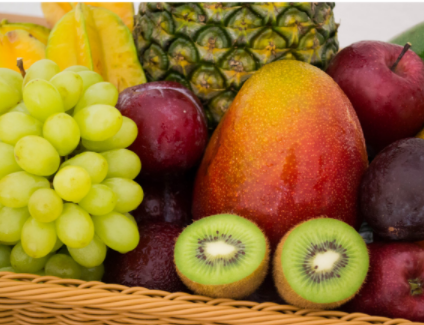A Long-Standing Debate: Fruits Vs. Vegetables
A look into the merits and drawbacks of both groups of food.

Photo Courtesy of Jonas Kakaroto on UNSPLASH
Fruits like kiwis, mangos, and pineapples have lots of Vitamin C.
February 28, 2022
Everyone is familiar with fruits and vegetables, from fearing watermelon seeds will grow in their stomachs as young children to drinking orange Fanta soda to enjoying potato fries (they count as fruits and vegetables, right?) at McDonald’s. However, when one thinks about it, what really makes a food, a fruit, or a vegetable, and which has better taste and nutritional benefits overall?
It is fairly easy to tell a fruit from a vegetable, although the way they are categorized may be unclear. From a purely physical standpoint, fruit comes from the flower of a plant and possesses seeds, while a vegetable may come from any other edible part of the plant, particularly the roots, leaves, and stalks. However, from a culinary perspective, fruits and vegetables are generally classified by taste. Fruits tend to be sweet or tart, while vegetables typically have a more specific savory flavor or may even be bitter. Many kinds of produce, such as tomatoes, belong to debated categories. Tomatoes develop from the flowers of a tomato plant and contain seeds, so they must be fruits. Nonetheless, tomatoes also have a more savory taste rather than a sweet or sour flavor, so from a cooking view, they would be considered vegetables.
Both foods have fantastic nutritional value, although some of their particular benefits vary slightly. According to the U.S. Department of Agriculture, incorporating either fruits or vegetables into one’s diet can reduce the risk of some chronic diseases, help sustain suitable blood pressure, lower cholesterol levels, strengthen teeth and heal wounds, and protect from some cancers. Each of these food groups are low in fat and calories and are major sources of vitamin C, potassium, and dietary fiber. The potassium found in fruits and vegetables helps maintain healthy blood pressure, while dietary fiber helps lower blood cholesterol levels. Dietary fiber and potassium may help limit the risk of heart disease since it is linked with high cholesterol and blood pressure. People with heart disease have heightened chances of experiencing strokes and heart attacks. Vitamin C is the nutrient that allows fruits and vegetables to maintain gums and teeth and mend cuts and wounds.
Despite their commonalities, fruits, unlike vegetables, are particularly low in sodium. High sodium in a person’s diet can lead to hypertension and heart disease. The MyPlate recommended daily sodium intake for a person over fourteen years of age is 2,300 milligrams, but according to the FDA, the average American consumes 3,400 milligrams of sodium each day. By eating more fruit, Americans could maintain healthier sodium levels. Vegetables, on the other hand, have the added bonus of being great sources of vitamin A. Vitamin A is known to boost the health of the skin and eyes. Vitamin A can also help guard against bacterial, parasitic, and viral infections by amplifying the activity of white blood cells in the immune system.
Overall, fruits and vegetables share most of their health benefits, although the particular nutrients can vary based on the specific fruit or vegetable. Therefore, the debate of fruits versus vegetables mostly depends upon a person’s preferences. Based upon interviews with fifteen students, 93% of students prefer fruits to vegetables. “I prefer fruits because they are sweeter and have more of a variety,” says Chloe Glazer (‘25). Many other students noted that they enjoy the sweet flavor that fruits have to offer as well. One anonymous freshman defended their stance on the dispute, explaining, “Personally, I prefer vegetables. I think the crisp vegetable flavor is far superior to that of the tangy fruit. I would rather eat a raw onion than a strawberry because onions have a stronger flavor.”
Altogether, fruits and vegetables are both very nutritious and have contrasting tastes, each with advantages and disadvantages. Therefore, one really cannot go wrong with either!






